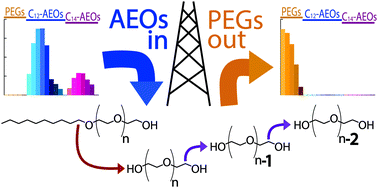In situ transformation of hydraulic fracturing surfactants from well injection to produced water†
Abstract
Chemical changes to hydraulic fracturing fluids (HFFs) within fractured unconventional reservoirs may affect hydrocarbon recovery and, in turn, the environmental impact of unconventional oil and gas development. Ethoxylated alcohol surfactants, which include alkyl ethoxylates (AEOs) and polyethylene glycols (PEGs), are often present in HFF as solvents, non-emulsifiers, and corrosion inhibitors. We present detailed analysis of polyethoxylates in HFF at the time of injection into three hydraulically fractured Marcellus Shale wells and in the produced water returning to the surface. Despite the addition of AEOs to the injection fluid during almost all stages, they were rarely detected in the produced water. Conversely, while PEGs were nearly absent in the injection fluid, they were the dominant constituents in the produced water. Similar numbers of ethoxylate units support downhole transformation of AEOs to PEGs through central cleavage of the ethoxylate chain from the alkyl group. We also observed a decrease in the average ethoxylate (EO) number of the PEG–EOs in the produced water over time, consistent with biodegradation during production. Our results elucidate an overlooked surfactant transformation pathway that may affect the efficacy of HFF to maximize oil and gas recovery from unconventional shale reservoirs.

- This article is part of the themed collection: The environmental geochemistry and biology of hydraulic fracturing


 Please wait while we load your content...
Please wait while we load your content...
